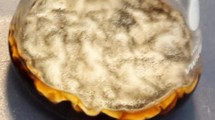Abstract
For the first time the production of poly(β-l -malic acid) (PMA) has been achieved using agricultural biomass substrates by the yeast-like fungus Aureobasidium pullulans. Strains NRRL Y-2311-1, NRRL 50382, NRRL 50383, and NRRL 50384, representing diverse isolation sources and phylogenetic clades, produced PMA from alkaline H2O2-pretreated corn fiber and wheat straw as sole carbon sources. Pretreated wheat straw was better than pretreated corn fiber, and strain NRRL 50383 gave the highest overall yields of PMA. The addition of CaCO3 plus supplementary hydrolytic enzymes enhanced PMA production. Four basal media were compared for PMA production, and the best was found to be a N-limited pullulan production medium (PM). In this medium, PMA production took place during growth limitation. Under optimal conditions, strain NRRL 50383 produced more than 20 g PMA/l from 5 % (w/v) pretreated wheat straw in PM with 3 % (w/v) CaCO3 and supplementary enzymes.


Similar content being viewed by others
References
Braud C, Bunel C, Vert M (1985) Poly(β-malic acid): a new polymeric drug-carrier. Evidence for degradation in vitro. Polym Bull 13:293–2997
Cao W, Luo J, Zhao J, Qiao C, Ding L, Qi B, Su Y, Wan Y (2012) Intensification of β-poly(L-malic acid) production by Aureobasidium pullulans ipe-1 in the late exponential growth phase. J Ind Microbiol Biotechnol. doi:10.1007/s10295-012-1111-3
Fischer H, Erdmann S, Holler E (1989) An unusual polyanion from Physarum polycephalum that inhibits homologous DNA polymerase in vitro. Biochemistry 28:5219–5226
Hibbett DS, Binder M, Bischoff JF et al (2007) A higher-level phylogenetic classification of the fungi. Mycol Res 111:509–547
Holler E, Angerer B, Achhammer G, Miller S, Windisch C (1992) Biological and biosynthetic properties of poly-L-malate. FEMS Microbiol Rev 103:109–118
Kurosawa T, Sakai K, Nakahara T, Oshima Y, Tabuchi T (1994) Extracellular accumulation of the polyol lipids, 3,5-dihydroxydecanoyl and 5-hydroxy-2-decenoyl esters of arabitol and mannitol, by Aureobasidium sp. Biosci Biotech Biochem 58:2057–2060
Leathers TD (1989) Purification and properties of xylanase from Aureobasidium. J Ind Microbiol 4:341–348
Leathers TD (2002) Pullulan. In: Vandamme EJ, De Baets S, Steinbüchel A (eds) Biopolymers, vol 6, Polysaccharides II: polysaccharides from eukaryotesWiley-VCH, Weinheim, pp 1–35
Leathers TD, Gupta SC (1996) Saccharification of corn fiber using enzymes from Aureobasidium sp strain NRRL Y-2311-1. Appl Biochem Biotechnol 59:337–347
Leathers TD, Price NPJ (2007) Effect of oil extraction method on enzymatic digestibility of corn germ arabinoxylan. Cereal Chem 84:243–245
Li R, Qiao C, Guo H, Xu Y (2011) Polymalic acid synthesis with Aureobasidium pullulans fermentation experiments. Shipin Yu Fajiao Keji 47:68–71
Liu S, Steinbuchel A (1996) Investigation of poly(β-L-malic acid) production by strains of Aureobasidium pullulans. Appl Microbiol Biotechnol 46:273–278
Liu S, Steinbuchel A (1997) Production of poly(malic acid) from different carbon sources and its regulation in Aureobasidium pullulans. Biotechnol Lett 19:11–14
Ljubimova JY, Fujita M, Khazenzon NM, Lee BS, Wachsmann-Hogiu S, Farkas DL, Black KL, Holler E (2008) Nanoconjugate based on polymalic acid for tumor targeting. Chemico-Biol Interact 171:195–203
Manitchotpisit P, Leathers TD, Peterson SW, Kurtzman CP, Li X-L, Eveleigh DE, Lotrakul P, Prasongsuk S, Dunlap CA, Vermillion KE, Punnapayak H (2009) Multilocus phylogenetic analyses, pullulan production and xylanase activity of tropical isolates of Aureobasidium pullulans. Mycol Res 113:1107–1120
Manitchotpisit P, Skory CD, Leathers TD, Lotrakul P, Eveleigh DE, Prasongsuk S, Punnapayak H (2011) α-Amylase activity during pullulan production and α-amylase gene analyses of Aureobasidium pullulans. J Ind Microbiol Biotechnol 38:1211–1218
Manitchotpisit P, Skory CD, Peterson SW, Price NPJ, Vermillion KE, Leathers TD (2012) Poly(β-L-malic acid) production by diverse phylogenetic clades of Aureobasidium pullulans. J Ind Microbiol Biotechnol 39:125–132
Nagata N, Nakahara T, Tabuchi T (1993) Fermentative production of poly(β-L-malic acid), a polyelectrolytic biopolyester, by Aureobasidium sp. Biosci Biotechnol Biochem 57:638–642
Nakajima-Kambe T, Hirotani N, Nakahara T (1996) Poly(beta-malic acid) production by the non-growing cells of Aureobasidium sp. strain A-91. J Ferm Bioeng 82:411–413
Qiao C, Zhong K, Hao H, Jia Y (2012) Optimization of poly(β-L-malic acid) production using Aureobasidium pullulans by response surface methodology. Appl Mech Mater 108:121–126
Saha BC, Nichols NN, Cotta MA (2011) Ethanol production from wheat straw by recombinant Escherichia coli strain FBR 5 at high solid loading. Biores Technol 102:10892–10897
Schoch CL, Shoemaker RA, Seifert KA, Hambleton S, Spatafora JW, Crous PW (2006) A multigene phylogeny of the Dothideomycetes using four nuclear loci. Mycologia 98:1042–1053
Singh RS, Saini GK, Kennedy JF (2008) Pullulan: microbial sources, production and applications. Carbohydr Polym 73:515–531
Vert M (1998) Chemical routes to poly(β-malic acid) and potential applications of this water-soluble bioresorbable poly(β-hydroxy alkanoate). Polym Degrad Stab 59:169–175
Wang L, Zheng Y, Liu T, Zhou H, Wan H, Wei P (2010) Optimization of fermentation conditions for poly(β-malic acid) production. Shengwu Jiagong Guocheng 8:41–45
Zhang H, Cai J, Dong J, Zhang D, Huang L, Xu Z, Cen P (2011) High-level production of poly (β-L-malic acid) with a new isolated Aureobasidium pullulans strain. Appl Microbiol Biotechnol 92:295–303
Acknowledgments
The authors thank Gregory J. Kennedy for experimental materials and advice. Expert technical assistance was provided by Melinda S. Nunnally. Purified PMA from Physarum polycephalum was the kind gift of Dr. Eggehard Holler, Cedars Sinai Medical Center.
Author information
Authors and Affiliations
Corresponding author
Additional information
Mention of any trade names or commercial products in this publication is solely for the purpose of providing specific information and does not imply recommendation or endorsement by the U.S. Department of Agriculture. USDA is an equal opportunity provider and employer.
Rights and permissions
About this article
Cite this article
Leathers, T.D., Manitchotpisit, P. Production of poly(β-l-malic acid) (PMA) from agricultural biomass substrates by Aureobasidium pullulans . Biotechnol Lett 35, 83–89 (2013). https://doi.org/10.1007/s10529-012-1045-x
Received:
Accepted:
Published:
Issue Date:
DOI: https://doi.org/10.1007/s10529-012-1045-x




